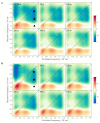The Energy Transfer Yield between Carotenoids and Chlorophylls in Peridinin Chlorophyll a Protein Is Robust against Mutations
- PMID: 35563456
- PMCID: PMC9099807
- DOI: 10.3390/ijms23095067
The Energy Transfer Yield between Carotenoids and Chlorophylls in Peridinin Chlorophyll a Protein Is Robust against Mutations
Abstract
The energy transfer (ET) from carotenoids (Cars) to chlorophylls (Chls) in photosynthetic complexes occurs with almost unitary efficiency thanks to the synergistic action of multiple finely tuned channels whose photophysics and dynamics are not fully elucidated yet. We investigated the energy flow from the Car peridinin (Per) to Chl a in the peridinin chlorophyll a protein (PCP) from marine algae Amphidinium carterae by using two-dimensional electronic spectroscopy (2DES) with a 10 fs temporal resolution. Recently debated hypotheses regarding the S2-to-S1 relaxation of the Car via a conical intersection and the involvement of possible intermediate states in the ET were examined. The comparison with an N89L mutant carrying the Per donor in a lower-polarity environment helped us unveil relevant details on the mechanisms through which excitation was transferred: the ET yield was conserved even when a mutation perturbed the optimization of the system thanks to the coexistence of multiple channels exploited during the process.
Keywords: 2DES; N89L; PCP; carotenoid; chlorophyll; energy transfer; light harvesting; peridinin; photosynthesis; two-dimensional electronic spectroscopy.
Conflict of interest statement
The authors declare no conflict of interest.
Figures





Similar articles
-
Consistent Model of Ultrafast Energy Transfer in Peridinin Chlorophyll-a Protein Using Two-Dimensional Electronic Spectroscopy and Förster Theory.J Phys Chem B. 2019 Aug 1;123(30):6410-6420. doi: 10.1021/acs.jpcb.9b04324. Epub 2019 Jul 19. J Phys Chem B. 2019. PMID: 31282681
-
Structural and spectroscopic characterization of the peridinin-chlorophyll a-protein (PCP) complex from Heterocapsa pygmaea (HPPCP).Biochim Biophys Acta Bioenerg. 2025 Jan 1;1866(1):149510. doi: 10.1016/j.bbabio.2024.149510. Epub 2024 Sep 24. Biochim Biophys Acta Bioenerg. 2025. PMID: 39321862
-
Molecular factors controlling photosynthetic light harvesting by carotenoids.Acc Chem Res. 2010 Aug 17;43(8):1125-34. doi: 10.1021/ar100030m. Acc Chem Res. 2010. PMID: 20446691 Free PMC article.
-
Spectroscopy of the peridinin-chlorophyll-a protein: insight into light-harvesting strategy of marine algae.Arch Biochem Biophys. 2007 Feb 15;458(2):111-20. doi: 10.1016/j.abb.2006.10.006. Epub 2006 Oct 27. Arch Biochem Biophys. 2007. PMID: 17098207 Review.
-
Structure and function of native and refolded peridinin-chlorophyll-proteins from dinoflagellates.Eur J Cell Biol. 2010 Dec;89(12):990-7. doi: 10.1016/j.ejcb.2010.08.004. Epub 2010 Sep 16. Eur J Cell Biol. 2010. PMID: 20846743 Review.
Cited by
-
Impact of Fluctuations in the Peridinin-Chlorophyll a-Protein on the Energy Transfer: Insights from Classical and QM/MM Molecular Dynamics Simulations.Biochemistry. 2025 Feb 18;64(4):879-894. doi: 10.1021/acs.biochem.4c00568. Epub 2025 Feb 4. Biochemistry. 2025. PMID: 39903904 Free PMC article.
-
Intramolecular charge-transfer enhances energy transfer efficiency in carotenoid-reconstituted light-harvesting 1 complex of purple photosynthetic bacteria.Commun Chem. 2022 Oct 26;5(1):135. doi: 10.1038/s42004-022-00749-6. Commun Chem. 2022. PMID: 36697849 Free PMC article.
References
-
- Collini E. Carotenoids in Photosynthesis: The Revenge of the “Accessory” Pigments. Chem. 2019;5:494–495. doi: 10.1016/j.chempr.2019.02.013. - DOI
-
- Zigmantas D., Polfvka T., Killer R.G., Yartsev A., Sundstrom V. Spectroscopic and Dynamic Properties of the Peridinin Lowest Singlet Excited States. J. Phys. Chem. A. 2001;105:10296–10306. doi: 10.1021/jp010022n. - DOI
MeSH terms
Substances
Grants and funding
LinkOut - more resources
Full Text Sources

